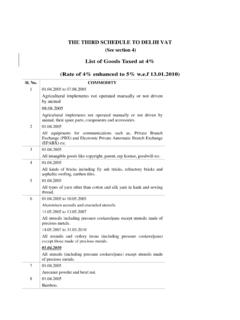Transcription of By Richard Campanella Tulane School of Architecture
1 30 Preservation in Print 2015he collapse of a 213-year-old townhouse at 808-810 Royal Street in the French Quarter this past October a classic example of the demolition-by-neglect, as neighborhood advocate Meg Lousteau put it prompted a city-wide conversation on the structural viability of New Orleans oldest neighbor-hood. Said architect John Williams in an interview with the Times-Picayune, the biggest problem facing the Vieux Carre is the aging of bricks and mor- tar. The life of a brick is between 150 and 200 years and mortar typically lasts between 75 and 100 years. [The Royal Street collapse] should be a wakeup get qualified brick masons to tuck point their buildings and in some instances replace the I guarantee you the mortar (in the collapsed building) was shot.
2 A lifespan on brick and mortar raises the question of the structural age of the French Quarter. How widespread is this problem, at least potentially? I aimed to understand the architectural geography of this district a few years ago via a spatial analysis of the Vieux Carr Survey, that amazing inventory (now on-line at ) of the 300-year-old neighborhood s chains of title and structural history. The results form a number of chapters in my 2006 book, Geographies of New Orleans (University of Louisiana Press), which map and analyze the chronology and geography of building styles, their architectural typologies, and their iron adornment. Here I will focus solely on the aspect of building age that is, an analysis of the Quarter s 2,244 extant street-fronting structures (as opposed to rear dependencies and outbuildings) based on when they were originally constructed.
3 Understanding the geography of building age sheds light on the location and distribution of edifices falling within that age window when bricks and mortar, if unmaintained, may start to disintegrate. Structurally speaking, today s French Quarter, for all its colonial roots and Caribbean-Mediterranean feel, is a decidedly 19th-century neighborhood erected after the city came under American dominion. Only one of every hundred structures standing today ( percent) dates to the 18th century, while over three of every four (77 percent) were built between 1800 and 1899 and one of five (21 percent) date from the 20th century. More specifically, 61 percent of the entire present-day Quarter arose be-tween the Battle of New Orleans (1815) and the onset of the Civil War (1861), especially the 1820s-1850s and in particular the 1830s.
4 Plotted as a histogram, we see four valleys (before 1820, 1860-1880, 1930-1960, and after 1980) in-terspersed among three peaks (1820-1860, 1880-1930, and in the 1960s and 1970s) in the construction dates of the French Quarter s extant Valley, before 1820 The relatively few (96) surviving structures predat-ing 1820 do not, of course, represent low levels of construction prior to that year. On the contrary, the Quarter was entirely developed by 1820, so much so that development had spread into adjacent faubourgs. Rather, this valley reflects the toll of time on centuries-old buildings in a busy, dense, subtropical port city. Parcels opened up by the disappearance of these ancient edifices, through either demolitions, disaster, or decay, were usually reoccupied during later peaks in construction.
5 It is not a coincidence that the collapsed building at 808-810 Royal, which according to my data ranked as the 37th oldest of the 2,244 buildings ana-lyzed, fell within this oldest cohort of neighborhood peak, circa 1820-1861 The rise of sugar cane and cotton, the arrival of Northerners and foreign immigrants, the development of the steamboat, and the city s monopoly on Mississippi Valley trade brought great wealth to New Orleans during the antebellum golden age. Hundreds of multistory edifices arose to meet the demand, especially in the 1830s, when New Orleans ranked among the wealthiest and largest cities in the nation. Illustrating the prosperity of this era is the fact that, of the 1294 extant structures built during 1820-1862, over half (52 percent) were sumptuous townhouses.
6 The French Quarter in these times consti-tuted a generally affluent residential neighborhood in its core blocks, with a busi-ness district along its upper and riverfront flanks and working-class populations in its lower and rear blocks. These patterns, too, are evident in the data: 21 per-cent of structures built in this era were storehouses, with commercial use on the ground floor and residences above, and another 20 percent were cottages, where working class residents were more likely to dwell. The decline in construction in the 1840s-1850s may be explained by a number of factors: full development of the neighborhood s parcels, increasing popularity of uptown and Esplanade Av-enue sites for new construction, repercussions of the Panic of 1837, and increasing trade competition in the form of Northern canal and railroad Valley, 1862-1877 The dearth of structures dating from these fifteen years reflects the turmoil of Civil War, blockade, federal occupation, and Re-construction.
7 Many local and regional businesses folded, investment dollars were limited, and few buildings went up. Only three percent of today s build-ings date from this Collapse Elicits Question on the Lifespan of Bricks and the Age of the French QuarterBy Richard CampanellaTulane School of ArchitectureTABOVE Collapsed circa-1801 townhouse at 808-810 Royal Street, October 2014. The build-ing was empty at the time and, miraculously, no one on busy Royal Street was injured. The site has since been cleared away. Photography by Richard Preservation in Print 31february 2015second peak, 1880-1920s New Orleans en-joyed a second (though much more modest) golden age in the turn-of-the-century era, which coincided with a minor construction boom in the French Quarter.
8 But while a num-ber of impressive Italianate townhouses and storehouses went up in this second peak, the new construction comprised mostly humble wooden abodes for families of modest means. The upper class had by this time departed for uptown or Es-planade Avenue, leaving the French Quarter to the working class, among them thousands of in-digent immigrants from Sicily who were accom-modated in old mansions subdivided into cheap rental flats. It was a phenomena seen in many big cities in this era: Vacated houses were converted into tenements and rooming houses, observed geographer David Ward in regard to national trends, while vacant lots and rear yards were filled with cheap new structures. In New Or-leans, those cheap new structures meant shotgun houses and bungalows.
9 Of the 196 shotguns and 18 bungalows now standing in the French Quar-ter, fully 88 percent were built during the 1880s to 1920s. And of the 525 total extant building erected during these four decades, only eight percent were upscale townhouses for the affluent. Third Valley, 1930-1950s A number of factors contributed to the decline in construction in these years. Depression and World War II diverted atten-tion and funds away from real estate investment, while in the midst of that era, designation of the French Quarter as a protected historic district (1937) regulated demolition and new construction. Tourism and conventions dur-ing this era, meanwhile, were at levels too low to motivate new hotel construc-tion. Countering these trends were the extensive renovations of the Works Progress Administration and Public Works Administration in the 1930s, especially in the French Market area, and the gerrymandering of the Vieux Carr Commission s jurisdiction to exclude certain Rampart Street blocks, the upper North Peters river side, and the 200 block of Royal, thus greenlight-ing a number of demolitions and modern constructions.
10 Third peak, 1950s-1970s The late 1950s to the mid-1970s saw the final boom in French Quarter construction, and it constituted mostly large multi-parcel hotels and affiliated structures such as parking garages. A moratorium on additional Quarter hotels has since quelled new construction, and since the 1980s, only a few new buildings have gone up, all by law designed to blend into the 19th-century scenography. How old, then, is the French Quarter? From a structural standpoint, the prototypical French Quarter streetscape dates to the second quarter of the 19th century, 1825-1850, with a few streetscapes pre-dating this era and a fair number post-dating it. This puts the lion s share of the neighborhood s build-ings in the 165-190 year old range, within the end-of-life timeframe of bricks estimated by John Williams.








